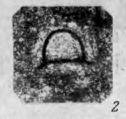
| Intro | | About | | Wiki | | Search traits | | Data explorer | | Literature | | Definitions | | Sources | | Webservices | | Statistics | | Feedback | | Editors | | Log in |
Foraminifera taxon detailsEotuberitina reitlingerae Miklukho-Maklay, 1958 †
917850 (urn:lsid:marinespecies.org:taxname:917850)
accepted
Species
Archaesphaera reitlingerae (Miklukho-Maklay, 1958) † · unaccepted
Neotuberitina reitlingerae (Miklukho-Maklay, 1958) † · unaccepted
marine,
fossil only
Miklukho-Maklay, A. D. (1958). Новое семейство фораминифер — Tuberitinidae M.-Maclay fam. nov. - New foraminiferal familiy Tuberitinidae M.-Maclay fam. nov. <em>Академия наук СССР Вопросы микропалеонтологии - Academy of Sciences USSR Questions of Micropaleontology.</em> 2: 130-135., available online at http://www.ginras.ru/library/pdf/02_1958_voprosy_mikropaleontologii.pdf
page(s): p. 134 (see Tuberitina maljavkini Suleymanov, 1948 of Reitlinger, 1950, p. 88, pl. 19, fig. 2). [details] Available for editors Reitlinger, E. A. (1950). Фораминиферы среднекаменноугольных отложений центральной части Русской платформы (исключая сем. Fusulinidае) - Foraminifera of the Middle Carboniferous deposits of the central part of the Russian Platform (exclusive of family Fusulinidae). <em>Академия наук СССР Труды ИГН-Academy of Sciences USSR Proceedings Insitute of Geological Sciences.</em> 126: 1-128., available online at http://www.ginras.ru/library/pdf/ign126_1950_reitlinger_carboniferous_forams.pdf page(s): p. 88, pl. 19, fig. 2 not fig. 3.; note: see Tuberitina maljavkini Suleymanov, 1948 [details] Available for editors
Original description The test is hemispherical to spherical, taking shape depending on the substrate. Sometimes a cluster of two or three...
Original description The test is hemispherical to spherical, taking shape depending on the substrate. Sometimes a cluster of two or three chambers is observed. The diameter varies greatly from 0.089 to 0.25 mm, the average diameter is 0.11-0.19 mm. The wall is very thin, microgranular, its thickness is 6.2-9.3 μ. There are no clear pores. No aperture was observed. Apparently, communication with the environment occurred due to very fine pores. Comparison. The test is similar in shape to the images given by Mikhailov for Tuberitina maljavkini Mikh. But, unfortunately, the author does not provide a description of the species indicating the dimensions and wall thickness. The measured images have diameters of 0.17 and 0.33 mm, which approximately corresponds to the diameters of our forms. Locality. The form is widespread both horizontally and vertically in the studied area. Age. Carboniferous. (Reitlinger (1950)). [details]
Hayward, B.W.; Le Coze, F.; Vachard, D.; Gross, O. (2025). World Foraminifera Database. Eotuberitina reitlingerae Miklukho-Maklay, 1958 †. Accessed at: https://marinespecies.org/foraminifera/aphia.php?p=taxdetails&id=917850 on 2025-05-14
Date action by
original description
Miklukho-Maklay, A. D. (1958). Новое семейство фораминифер — Tuberitinidae M.-Maclay fam. nov. - New foraminiferal familiy Tuberitinidae M.-Maclay fam. nov. <em>Академия наук СССР Вопросы микропалеонтологии - Academy of Sciences USSR Questions of Micropaleontology.</em> 2: 130-135., available online at http://www.ginras.ru/library/pdf/02_1958_voprosy_mikropaleontologii.pdf
page(s): p. 134 (see Tuberitina maljavkini Suleymanov, 1948 of Reitlinger, 1950, p. 88, pl. 19, fig. 2). [details] Available for editors basis of record Ellis, B. F.; Messina, A. R. (1940-2015). Catalogue of Foraminifera. <em>Micropaleontology Press, American Museum of Natural History, New York.</em> [details] original description (unavailable nomenclaturally) Reitlinger, E. A. (1950). Фораминиферы среднекаменноугольных отложений центральной части Русской платформы (исключая сем. Fusulinidае) - Foraminifera of the Middle Carboniferous deposits of the central part of the Russian Platform (exclusive of family Fusulinidae). <em>Академия наук СССР Труды ИГН-Academy of Sciences USSR Proceedings Insitute of Geological Sciences.</em> 126: 1-128., available online at http://www.ginras.ru/library/pdf/ign126_1950_reitlinger_carboniferous_forams.pdf page(s): p. 88, pl. 19, fig. 2 not fig. 3.; note: see Tuberitina maljavkini Suleymanov, 1948 [details] Available for editors From editor or global species database
Original description The test is hemispherical to spherical, taking shape depending on the substrate. Sometimes a cluster of two or three chambers is observed. The diameter varies greatly from 0.089 to 0.25 mm, the average diameter is 0.11-0.19 mm. The wall is very thin, microgranular, its thickness is 6.2-9.3 μ. There are no clear pores. No aperture was observed. Apparently, communication with the environment occurred due to very fine pores.Comparison. The test is similar in shape to the images given by Mikhailov for Tuberitina maljavkini Mikh. But, unfortunately, the author does not provide a description of the species indicating the dimensions and wall thickness. The measured images have diameters of 0.17 and 0.33 mm, which approximately corresponds to the diameters of our forms. Locality. The form is widespread both horizontally and vertically in the studied area. Age. Carboniferous. (Reitlinger (1950)). [details] |

